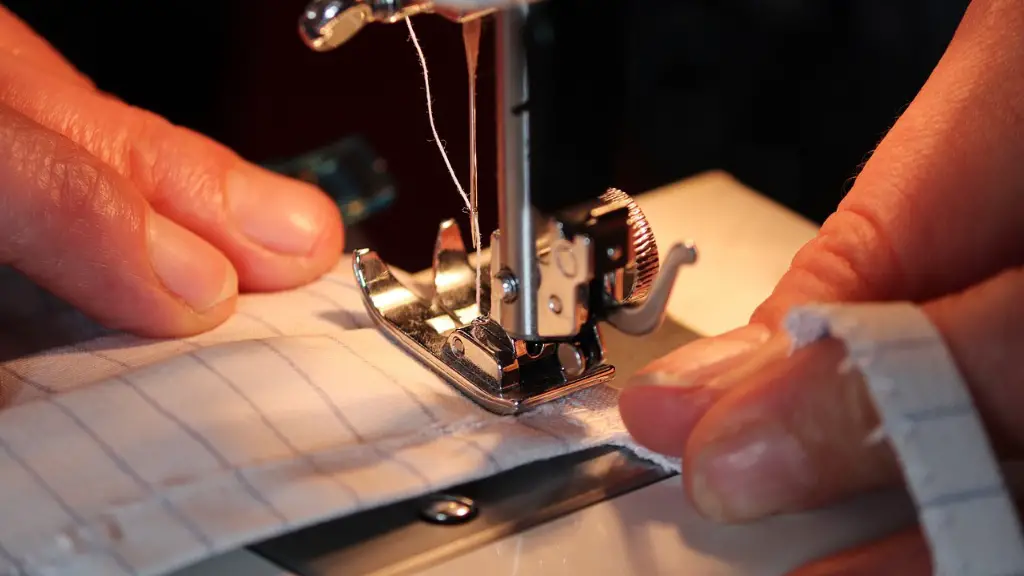Background Information
A sewing needle is the essential component of a sewing machine. Also known as a sewing awl, it is used to join together overlapping pieces of fabric or to attach trim or decorations to fabrics or other materials. It is a small, pointed metal object with a sharp point at one end and a loop at the other. It is usually made of stainless steel or brass and is available in a variety of sizes, depending on the application.
Steps to Replace a Sewing Machine Needle
1. Turn off the power to the sewing machine: Before beginning any work on your machine, you should always turn off its power. This will protect you from possible injury and also ensure that no harm comes to the machine.
2. Pull out the presser foot and remove the needle: After turning off the machine’s power, pull down the presser foot and use the screwdriver to loosen and remove the needle from the machine’s clamp.
3. Choose the appropriate needle: Select the needle that is suited for the fabric and thread you will be working with, and check its size. Needles are usually labeled with a number, such as 80/12 or 90/14, indicating their size. Smaller numbers refer to smaller needles and thicker numbers to larger needles.
4. Insert the new needle: Fit the new needle into the clamp, making sure that it is secured tightly. Check that the flat side of the needle is facing the back of the machine, as this will ensure better stitching.
5. Thread the machine: Once the needle has been inserted, thread the machine. This can be quite tricky, so make sure you read through the machine’s user manual to get precise instructions.
6. Test the stitch: To ensure that everything is working properly, test the stitch before beginning to sew. This will help you avoid any problems and will ensure that everything is set up correctly.
Safety Measures to Follow
1. Wear protective gear: Wear the appropriate protective gear, such as gloves and goggles, while working to protect yourself from cuts and splinters.
2. Keep the needle away from children: Keep the sewing machine needles away from children, as they can be dangerous if handled incorrectly.
3. Handle the needle with care: Handle the needle with care, as it is sharp and can easily break or bend if mishandled. Make sure that you use the proper tools to remove it, and do not try to remove it with your hands.
4. Dispose of the needle safely: Dispose of the old needle properly. Do not throw it away, as this could pose a danger to animals or other people. Instead, wrap it in paper and place it in a safe container.
The Right Way to Store Needles
1. Keep needles in a safe place: Store your needles in a safe place. Keep them away from children and pets, and away from any other sharp or metallic objects, as they can easily be damaged by any contact.
2. Store needles away from sunlight: Keep the needles away from direct sunlight, as this may cause them to become brittle and turn a yellow-brown color.
3. Label your needles: Label your needles so that you know what size and type of needle you have. This will make it easier when you need to replace needles in the future.
Options to Consider
1. Needle types: There are many different types of needles available for different types of fabrics and thread types. Choose a needle that is suited for the specific garment you will be working on, so that the fabric does not get damaged in the process.
2. Needle sizes: Needles come in various sizes. A larger needle will be best for thicker fabric and multiple layers of fabric, while a smaller needle will be best for thin and delicate fabrics.
3. Needle brands: There are many different sewing needle brands out there, so keep in mind the quality and durability of the needles you choose. Cheaper needles may break or bend more easily.
Caring For Your Sewing Machine
1. Regularly clean and lubricate the machine: Regularly clean and lubricate the sewing machine to keep it in top condition. This will help to prevent any damage and will also help to ensure that the machine is working as it should.
2. Replace the needle regularly: Replace the needle regularly to keep your stitches even and consistent. If the needle becomes dull or bent, replace it as soon as possible.
3. Purchase a dust cover: Purchase a dust cover to protect the machine from dust, dirt, and other debris. This will help to extend the life of the machine and ensure that it functions properly.
4. Store the machine in a cool and dry place: Store the sewing machine in a cool and dry location, away from direct sunlight and humidity. This will help to keep it in good condition and will help to extend its life.
Issues to Avoid
1. Do not force the needle: Never force the needle into the fabric, as this can cause it to become bent or broken.
2. Do not over tighten the needle: Make sure that the needle is not over tightened, as this could cause it to break.
3. Do not use the wrong size needle: Always use the correct size needle for the fabric and thread being used.
4. Do not reuse old needles: Do not reuse needles, as they can become damaged or dull after extensive use.

